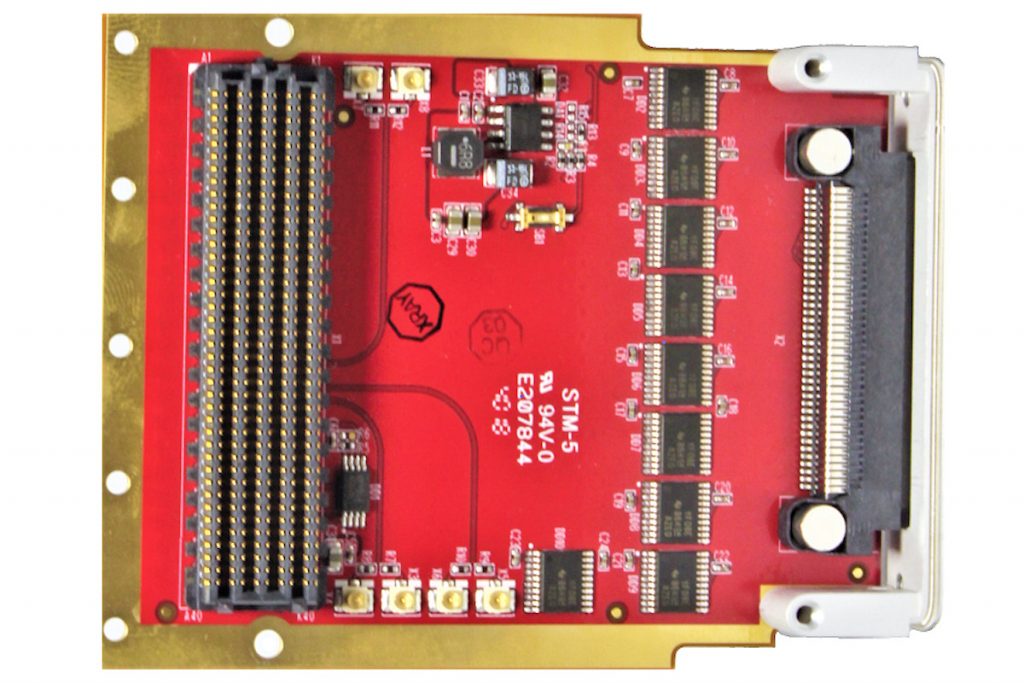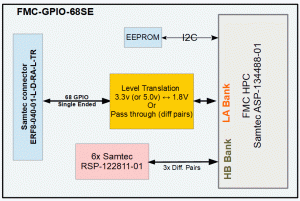Introduction
In the dynamic world of FPGA development, the need for flexible and reliable input/output (I/O) interfaces is critical for building robust systems. Among the various FMC IO modules available, the FMC-GPIO68SE from Sundance DSP stands out for its general-purpose I/O (GPIO) capabilities and unique voltage level conversion features. This article explores the applications, use cases, and benefits of the FMC-GPIO68SE, introducing it to developers seeking a versatile solution for their FPGA-based projects.
Key Features of the FMC-GPIO68SE
The FMC-GPIO68SE is engineered to offer maximum flexibility and compatibility. Its key features include:
|
Feature |
Description |
|---|---|
|
68 Single-Ended GPIO or 34 Differential Pairs |
Supports a wide range of applications, from simple digital I/O to high-speed differential signaling. |
|
Auto-Sense Level Translation |
Automatically detects and converts between 1.8V, 3.3V, and 5V, simplifying integration in mixed-voltage systems. |
|
Pass-Through Option |
Allows signals to bypass level translation when not needed, preserving signal integrity. |
|
Conduction Cooled |
Designed for rugged environments where forced air cooling is impractical. |
|
Compatibility |
Works with Sundance DSP’s PXIe700, PXIe800, SE120, and PCIe104Z boards, as well as third-party FPGA cards. |
|
Additional Connectors |
Includes 6 Samtec RSP-122811-01 connectors for 3 differential pairs, useful for external clock or synchronization signals. |
These features make the FMC-GPIO68SE a highly adaptable module for a variety of FPGA-based applications.
Applications
The FMC-GPIO68SE is well-suited for several domains where flexible I/O and voltage compatibility are essential. The primary applications include:
Signal Conditioning and Processing
In systems requiring real-time data acquisition and processing, the FMC-GPIO68SE facilitates seamless interfacing with sensors and actuators. Its GPIO capabilities allow developers to connect to a wide range of devices, such as temperature sensors, pressure transducers, or analog-to-digital converters, enabling signal conditioning tasks like amplification and filtering.
Defense
Defense applications, such as radar systems, communication equipment, and electronic warfare, demand high reliability and precise interfacing. The FMC-GPIO68SE’s ability to handle mixed voltage levels ensures compatibility with various subsystems, while its conduction-cooled design supports operation in harsh environments like military vehicles or aerospace platforms.
Medical Devices
Medical devices, particularly those involving patient monitoring (e.g., ECG, EEG), rely on accurate data acquisition from sensors. The FMC-GPIO68SE’s voltage level translation simplifies integration with medical sensors that may operate at different voltages, ensuring reliable data transfer to the FPGA for processing.
Industrial Control
In industrial automation, controlling machinery and monitoring processes often involve interfacing with devices that operate at different voltage levels. The FMC-GPIO68SE bridges these differences, enabling seamless communication between PLCs, actuators, and FPGA-based control systems.
Use Cases
The versatility of the FMC-GPIO68SE translates into several practical use cases, each leveraging its unique features:
|
Use Case |
Description |
How FMC-GPIO68SE Helps |
|---|---|---|
|
Mixed Voltage System Integration |
Connecting an FPGA (1.8V) to a 5V sensor in a data acquisition system. |
Auto-sense level translation eliminates the need for external level shifters, simplifying design. |
|
Rapid Prototyping |
Developing a prototype with multiple I/O requirements. |
Provides 68 GPIO pins or 34 differential pairs, offering flexibility without custom hardware. |
|
Rugged Environments |
Deploying systems in harsh conditions, like oil exploration or military applications. |
Conduction-cooled design ensures reliability in environments without forced air cooling. |
|
Custom I/O Expansion |
Expanding I/O capabilities of an FPGA board with limited pins. |
Adds significant I/O capacity, supporting complex interfacing needs. |
Example: Mixed Voltage System Integration
Consider a scenario where an FPGA operating at 1.8V needs to interface with a 5V temperature sensor in an industrial monitoring system. The FMC-GPIO68SE can automatically convert the sensor’s 5V signals to 1.8V for the FPGA, ensuring seamless communication without additional hardware. This capability reduces design complexity and accelerates development.
Example: Rapid Prototyping
During the prototyping phase of a new signal processing system, developers may need to test various sensor configurations. The FMC-GPIO68SE’s flexible I/O options allow quick connections to different sensors and actuators, enabling rapid iteration without the need for custom-designed boards.
Example: Rugged Environments
In a military radar system deployed in a desert environment, the FMC-GPIO68SE’s conduction-cooled design ensures reliable operation despite high temperatures and a lack of airflow. Its ability to interface with multiple subsystems at different voltage levels makes it a critical component in such applications.
Example: Custom I/O Expansion
For an FPGA board with limited I/O pins, such as the PicoZED 7030 mentioned in online discussions, the FMC-GPIO68SE can expand the available I/O to 68 single-ended pins or 34 differential pairs, supporting complex applications like multi-sensor data acquisition.
Benefits for Developers
The FMC-GPIO68SE offers several advantages that make it an attractive choice for FPGA developers:
-
Ease of Integration: The auto-sense level translation feature simplifies the design of systems with mixed voltage requirements, reducing the need for external components and minimizing design errors.
-
Flexibility: The ability to configure pins as single-ended or differential pairs allows developers to adapt the card to a wide range of project needs, from low-speed digital I/O to high-speed signaling.
-
Broad Compatibility: Support for Sundance DSP’s carrier boards (PXIe700, PXIe800, SE120, PCIe104Z) and third-party FPGA cards ensures the card can be integrated into various systems, enhancing its utility.
-
Reliability in Harsh Environments: The conduction-cooled design makes it suitable for applications in rugged settings, such as defense or industrial automation, where reliability is paramount.
-
Cost-Effectiveness: By eliminating the need for external level shifters and providing a versatile I/O interface, the card reduces development costs and time-to-market.
Technical Details for Developers
For developers looking to integrate the FMC-GPIO68SE into their projects, here are some technical considerations:
-
Connector: The card uses a Samtec ERF8-040-01-L-D-RA-L-TR connector at the front bezel for the 68 single-ended GPIO pins, and 6 Samtec RSP-122811-01 connectors for 3 differential pairs, which are useful for external clock or synchronization signals.
-
Voltage Adjustment: The card draws its Vadj (adjustable voltage) from the carrier board, ensuring compatibility with the FPGA’s voltage requirements.
-
Build Options: Developers can choose a pass-through configuration for some or all I/O pins, bypassing level translation if needed for specific applications.
-
3D Model: A 3D model of the card is available for design integration: 3D Viewer Online.
Conclusion
The FMC-GPIO68SE is a powerful and versatile FPGA Mezzanine Card that addresses the challenges of interfacing in mixed-voltage environments. Its 68 single-ended GPIO pins or 34 differential pairs, combined with auto-sense level translation and conduction-cooled design, make it an ideal choice for applications in signal processing, defense, medical devices, and industrial control. For developers, the card offers ease of use, flexibility, and compatibility, making it a valuable tool for both prototyping and production environments. Whether you’re building a complex data acquisition system or expanding the I/O capabilities of an FPGA board, the FMC-GPIO68SE provides a reliable and efficient solution.
For more information, visit the product page: Sundance DSP – FMC-GPIO68SE.


